India Direct to Consumer Ecommerce Market Size
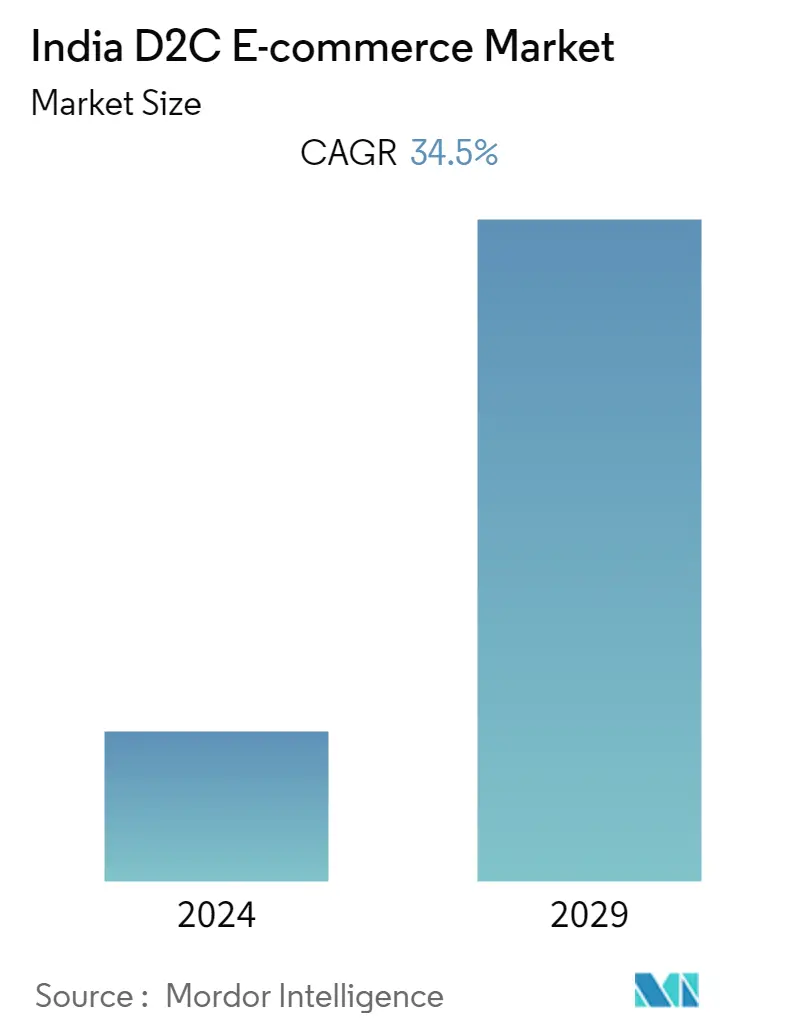
| Study Period | 2019 - 2029 |
| Base Year For Estimation | 2023 |
| Forecast Data Period | 2024 - 2029 |
| Historical Data Period | 2019 - 2022 |
| CAGR | 34.50 % |
| Market Concentration | Medium |
Major Players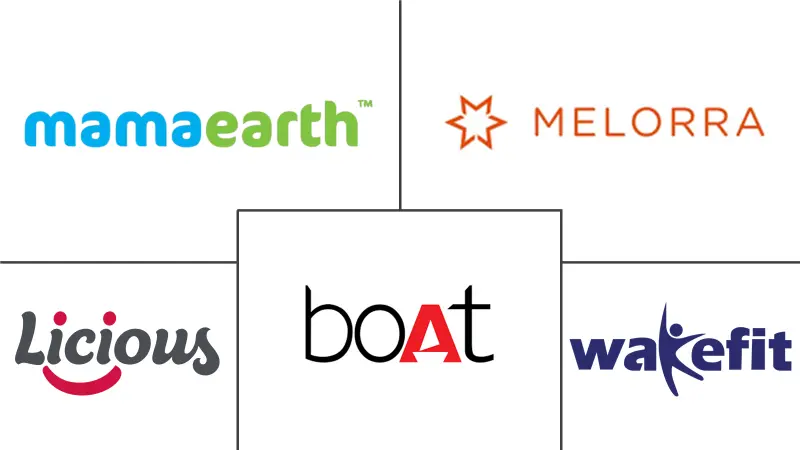
*Disclaimer: Major Players sorted in no particular order |
Need a report that reflects how COVID-19 has impacted this market and its growth?
India Direct to Consumer Ecommerce Market Analysis
The India D2C E-commerce market is expected to grow at a CAGR of 34.5% during the forecast period, 2022-2027. The Covid-19 pandemic-induced lockdown and mobility restrictions represented a significant point for D2C e-commerce in India. The pandemic has compelled sellers and new shoppers into digital platforms.
- Direct-to-consumer (D2C) E-commerce involves companies manufacturing and shipping their products directly to buyers without relying on third-party entities or mediators like traditional retail stores. Direct sales create a medium of communication between the buyer and brand. This enables to build brand loyalty, learn customer preferences, and generate repeat and recommended purchases.
- Factors like high consumer spending and rising e-commerce penetration are anticipated to drive the D2C market in the study period in India. Additionally, D2C e-commerce offers customers the flexibility and convenience of buying the product of their choice. This has increased the customer attraction towards online shopping.
- A significant benefit of having a D2C E-commerce strategy is that manufacturers get complete control of all their activities, from packaging to marketing. The Good Glamm Group has 200 million active users, 50 million social media followers, and 4.5 million monthly organic impressions, which shows that the D2C model is efficient in bringing out effective growth.
- With the help of the D2C model, a startup can directly pitch their product and sell directly to the shoppers. This eliminates the inefficiencies of the traditional supply chain and allows brands to connect to the customers. The major D2C brands in the studied market include mamaearth, a unicorn startup valued at more than USD 1 billion. The startup has successfully sold directly to its customer and built trust over a short time.
- However, the D2C online platforms, especially the startups, face challenges with the supply chain visibility as the consumers need their orders to be fully transparent, which requires an efficient delivery tracking system for any D2C brand.
India Direct to Consumer Ecommerce Market Trends
This section covers the major market trends shaping the India D2C E-commerce Market according to our research experts:
Fashion is Expected to Hold the Largest Market Share
- The Covid-19 outbreak has propelled the traditional retail sectors to shift toward a digital-first, direct-to-consumer(D2C) model. The fashion industry has witnessed a major shift as it adopted and promoted digital transformation.
- India is also witnessing an evolution in consumer types. Women, the new class of consumers, now form almost half of the online shoppers. Consumption trends are also evolving, and large pockets of product and price white spaces remain untapped by industry incumbents. New-age consumers seeking niche and customized products are underserved by traditional players. D2C brands can be noted to target the existing gaps in the fashion industry.
- Moreover, the trending digital platforms have made the D2C model more accessible and reliable for quick and comfortable shopping. The digital platforms have attracted a lot of targeted audiences and added more buyers according to different preferences while indulging in extensive marketing campaigns.
- The players in the market are investing in mergers and acquisitions in order to establish and expand their digital e-commerce footprint. For instance, in February 2022, Aditya Birla Fashion and Retail Limited (ABFRL) announced to set up an entity that will acquire digital brands across fashion, beauty, and other lifestyle segments to build direct-to-consumer brands. The firm will accelerate the process of building the D2C framework and identifying key skills for this entity by tapping into the broader tech ecosystem and will collaborate effectively with its e-commerce partners.
- Furthermore, the increased smartphone penetration and the comfort of online shopping are also driving the e-commerce D2C sales in India's fashion segment. According to Avendus, India has over 700 million internet users, and the start-ups continuously innovate and integrate technology in their operations and offerings. They have seen a rapid surge in their growth and other prospects.
- The start-ups in India benefit from the D2C model for their survival in a competitive marketplace dominated by large players. Indis has over 600 D2C brands, which is witnessing a rise by the launch of emerging start-ups in the market. Furthermore, fashion brands are increasingly focussing on the D2C channel as the growth trajectory in the country has been exponential. Brands like Zivame have reached the INR 100 crore mark within a short period of 7 years setting benchmark growth rates in the country.
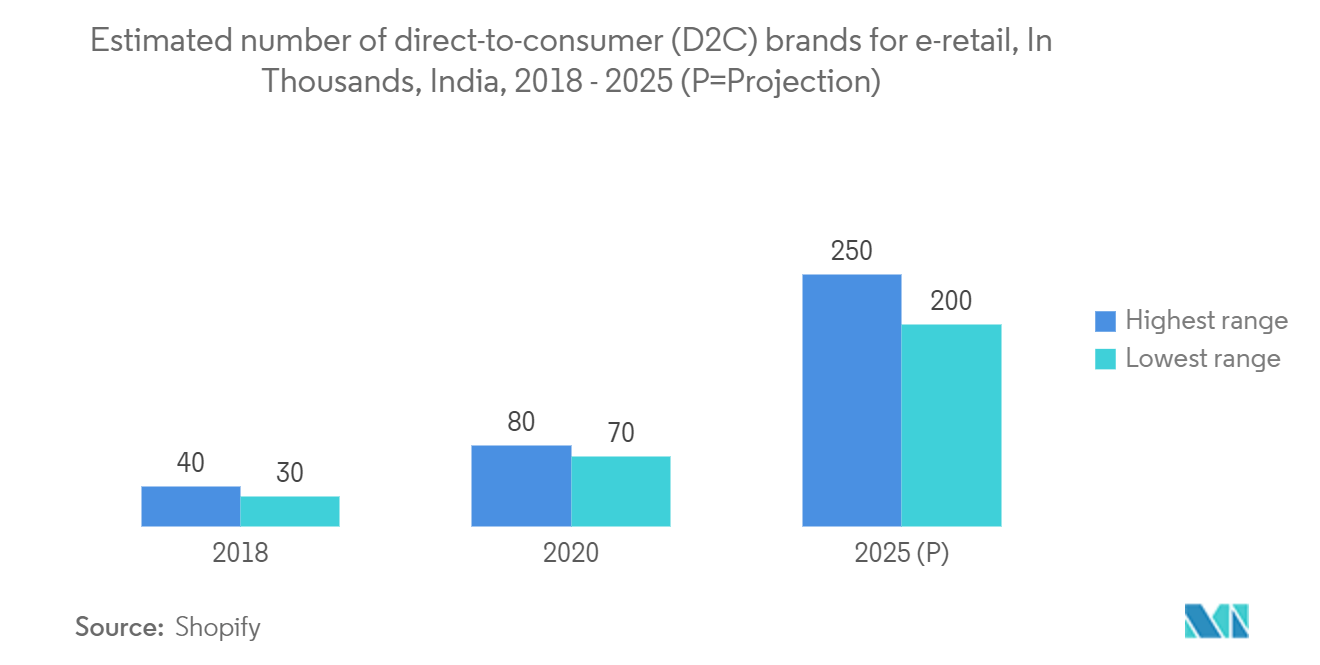
Personal Care to Drive Market Growth
- The shifts caused by the covid-19 pandemic changed consumer behavior, and the country is witnessing the increasing adoption of herbal cosmetics and homemade products. The segment is expected to see a growing trend in the coming years. It is driving growth, and the segment is expected to grow in the coming years.
- India has significant rising players in the D2C personal care segment. The companies like Mamaearth, m-caffeine, Oziva, Sugar Cosmetics, Habbit, Plumm, MyGlamm, and other digital-first personal care brands have successfully carved out a niche in the market. They have developed a robust connection with their consumers.
- According to Invest India, the online shopper base in India is predicted to be the second largest globally by 2030, with nearly 500-600 million shoppers. The D2C Ecommerce will benefit from government initiatives to boost rural broadband penetration within the ambit of Digital India. Such initiatives by the government are boosting the e-commerce sector in India, which in turn is accelerating the D2C e-commerce market in the country.
- The Personal care sector is witnessing rising demand in India, and firms are making strategic acquisitions in order to meet the customer's demand. In December 2021, ITC announced the acquisition of the D2C brand Mother Sparsh, and the company has acquired an 8.70 percent equity stake in Mother Sparsh Baby Care. The acquisition will facilitate access to the fast-growing direct-to-consumer (D2C) space in the 'personal care category.
- Moreover, the brands in the country are expanding their product portfolio by stepping into the personal beauty segment. For instance, in July 2021, Bewakoof, D2C apparel and accessories firm, announced the launch of its beauty and personal care products under the brand Cosmos Beauty.
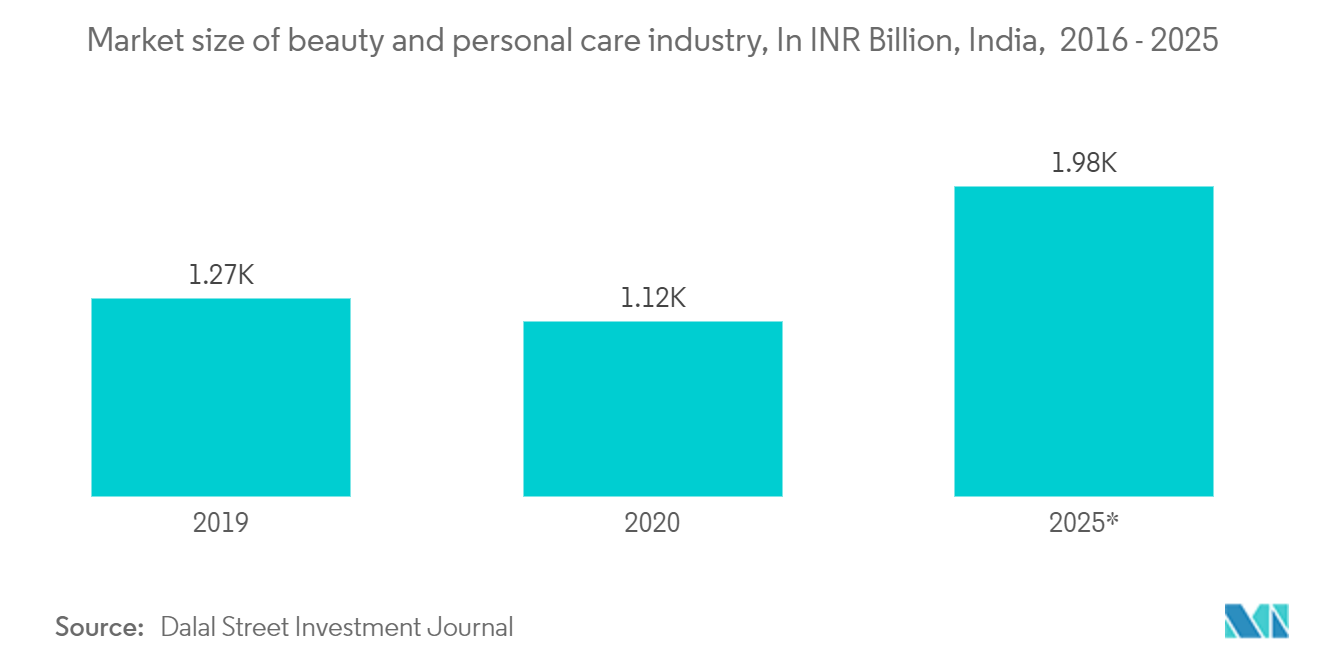
India Direct to Consumer Ecommerce Industry Overview
Many local firms have expanded in the India D2C e-commerce business, resulting in fierce competition. Some key players are Mamaearth, BoAt(Imagine Marketing Services Pvt. Ltd.), and Bewakoof Brands Pvt. Ltd. Product launches, high expenses on R&D, acquisitions and partnerships, etc., are the growth strategies adopted by such companies to sustain the intense competition.
- March 2022 - Licious, a Bengaluru-based start-up that is an online meat retailer, announced that it had raised an additional USD 150 million from a set of late investors for its fresh animal protein e-commerce platform.
- March 2022 - Acefour Accessories, a travel accessories company, announced that it had raised USD 1.5 million in a seed funding round. The D2C firm will shortly launch a premium range of travel accessories. The company is presently building the team, robusticity the manufacturing and supply chain, and investing in technology for order management and logistics.
India Direct to Consumer Ecommerce Market Leaders
Mamaearth (Honasa Consumer Private Limited)
BoAt lifestyle (Imagine Marketing Services Pvt. Ltd.)
Licious (Delightful Gourmet Pvt Ltd.)
Melorra
Wakefit Innovations Pvt. Ltd.
*Disclaimer: Major Players sorted in no particular order
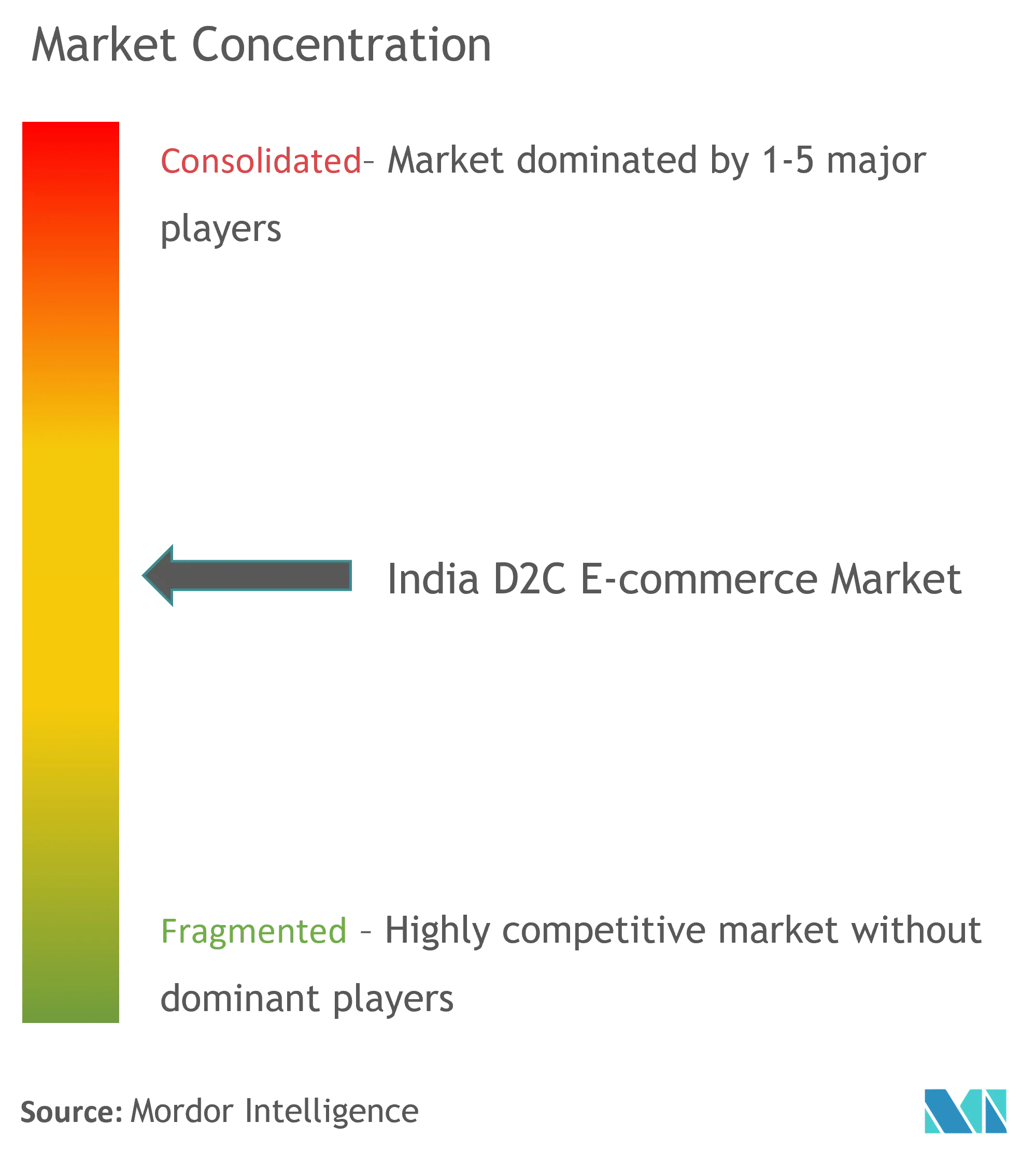
India Direct to Consumer Ecommerce Market News
- June 2022 - Goat Brand Labs, an Indian direct-to-consumer brand aggregator, announced that it had raised USD 50 million in fresh funding to acquire more premium brands and help them scale globally. The brand acquires lifestyle brands and helps them enhance their business in a continuously changing e-commerce marketplace.
- April 2022 - Flipkart group announced the acquisition of ANS Commerce, a full-stack e-commerce enabler. The acquisition will provide Flipkart with new SaaS services through ANS commerce to help Indian brands enhance their D2C model.
India Direct to Consumer Ecommerce Market Report - Table of Contents
1. INTRODUCTION
1.1 Study Assumptions and Market Definition
1.2 Scope of the Study
2. RESEARCH METHODOLOGY
3. EXECUTIVE SUMMARY
4. MARKET INSIGHT
4.1 Market Overview
4.2 Industry Value Chain Analysis
4.3 Industry Attractiveness - Porter's Five Forces Analysis
4.3.1 Bargaining Power of Suppliers
4.3.2 Bargaining Power of Buyers
4.3.3 Threat of New Entrants
4.3.4 Threat of Substitutes
4.3.5 Intensity of Competitive Rivalry
4.4 An Assessment of the Impact of COVID-19 on the Market
5. MARKET DYNAMICS
5.1 Market Drivers
5.1.1 Higher Profit Margins by Cutting Down Intermediaries have Encouraged Several Companies to Enter the Market
5.1.2 Enhanced brand engagement with customers have led to higher retention
5.2 Market Challenges
5.2.1 Higher Customer Acquisition Costs
6. MARKET SEGMENTATION
6.1 By End-User Vertical
6.1.1 Apparel and Footwear
6.1.2 Grocery and Gourmet
6.1.3 Personal Care
6.1.4 Home Decor and Household Supplies
6.1.5 Healthcare
6.1.6 Jewellery
7. COMPETITIVE LANDSCAPE
7.1 Company Profiles
7.1.1 Mamaearth (Honasa Consumer Private Limited)
7.1.2 BoAt lifestyle (Imagine Marketing Services Pvt. Ltd.)
7.1.3 Licious (Delightful Gourmet Pvt Ltd.)
7.1.4 Melorra
7.1.5 SUGAR Cosmetics
7.1.6 Noise
7.1.7 Bewakoof Brands Pvt. Ltd.
7.1.8 Country Delight
7.1.9 Nykaa E-Retail Pvt. Ltd
7.1.10 Wakefit Innovations Pvt. Ltd.
- *List Not Exhaustive
8. INVESTMENT ANALYSIS
9. FUTURE OF THE MARKET
India Direct to Consumer Ecommerce Industry Segmentation
The market study includes the evolving customer journey across various online D2C models, key drivers influencing growth, challenges, and major technologies that will drive innovation in the India D2C E-commerce market. The market tracks the revenues accrued by companies selling directly to the customers through their own website or app without the intervention of any other third party.
The India D2C E-commerce market is segmented by End-User Vertical (Apparel and Footwear, Grocery and Gourmet, Personal Care, Home Décor and Household Supplies, Healthcare and Jewellery).
| By End-User Vertical | |
| Apparel and Footwear | |
| Grocery and Gourmet | |
| Personal Care | |
| Home Decor and Household Supplies | |
| Healthcare | |
| Jewellery |
India Direct to Consumer Ecommerce Market Research FAQs
What is the current India D2C E-commerce Market size?
The India D2C E-commerce Market is projected to register a CAGR of 34.5% during the forecast period (2024-2029)
Who are the key players in India D2C E-commerce Market?
Mamaearth (Honasa Consumer Private Limited), BoAt lifestyle (Imagine Marketing Services Pvt. Ltd.), Licious (Delightful Gourmet Pvt Ltd.), Melorra and Wakefit Innovations Pvt. Ltd. are the major companies operating in the India D2C E-commerce Market.
What years does this India D2C E-commerce Market cover?
The report covers the India D2C E-commerce Market historical market size for years: 2019, 2020, 2021, 2022 and 2023. The report also forecasts the India D2C E-commerce Market size for years: 2024, 2025, 2026, 2027, 2028 and 2029.
What are the key drivers of growth in the India D2C E-Commerce Sector?
Key factors driving India's D2C E-Commerce Sector are: a) Rise in digital literacy b) Growing smartphone usage c) Convenience of online shopping d) Desire for authentic brand engagement
India D2C E-commerce Industry Report
Statistics for the 2024 India D2C E-commerce market share, size and revenue growth rate, created by Mordor Intelligence™ Industry Reports. India D2C E-commerce analysis includes a market forecast outlook 2029 and historical overview. Get a sample of this industry analysis as a free report PDF download.
